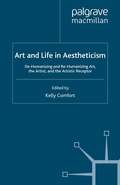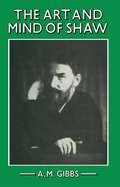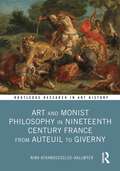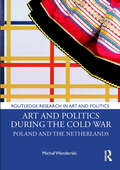- Table View
- List View
Art and knowledge after 1900: Interactions between modern art and thought
by James Fox and Vid SimonitiThis ground-breaking new history of modern art explores the relationship between art and knowledge from the beginning of the twentieth century to the present day. Each chapter examines artistic responses to a particular discipline of knowledge, from quantum theory and theosophy to cybernetics and ethnic futurisms. The authors argue that art’s incursion into other intellectual disciplines is a defining characteristic of both modernism and postmodernism. Throughout, the volume poses a series of larger questions: is art a source of knowledge? If so, what kind of knowledge? And, ultimately, can it contribute to our understanding of the world in ways that thinkers from other fields should take seriously?
Art and Life in Aestheticism: De-Humanizing and Re-Humanizing Art, the Artist and the Artistic Receptor
by Kelly ComfortArt for art's sake addresses the relationship between art and life. Although it has long been argued that aestheticism aims to de-humanize art, this volume seeks to consider the counterclaim that such de-humanization can also lead to re-humanization and to a deepened relationship between the aesthetic sphere and the world at large.
Art and Life in Modernist Prague: Karel Čapek and his Generation, 1911-1938 (Palgrave Studies in Cultural and Intellectual History)
by T. OrtIn most contemporary historical writing the picture of modern life in Habsburg Central Europe is a gloomy story of the failure of rationalism and the rise of protofascist movements. This book tells a different story, focusing on the Czech writers and artists distinguished by their optimistic view of the world in the years before WWI.
The Art and Life of Merritt Dana Houghton in the Northern Rockies, 1878-1919
by Michael A. AmundsonBetween 1891 and 1915, pen-and-ink artist Merritt Dana Houghton made over 200 bird’s-eye sketches of towns, ranches, mines, businesses, historic sites, and animals in Wyoming, northern Colorado, Montana, Idaho, and Washington state. Historian Michael A. Amundson brings these many views together for the first time in these pages. This lavishly illustrated biography details Houghton’s life and work from his birth in Michigan in 1846 to his death in 1919 in Spokane through extensive genealogical records, newspaper accounts, and his illustrations—including historic ranches and bird’s-eye views of Fort Collins, Colorado; Dillon, Montana; and Spokane, Washington and the only known illustrations of long-lost places like Pearl, Colorado, and Rambler, Wyoming. Also included is reproduction of a four-foot-by-eight-foot view of Sheridan, Wyoming and a sixty-image sample portfolio of his best-preserved illustrations organized by type. Houghton’s work depicts the infrastructure of the new settler society that was remaking the West in the late nineteenth century and early twentieth century, and Amundson demonstrates how Houghton’s vision of the American West remains active today.
Art and Merchandise in Keith Haring’s Pop Shop (Routledge Advances in Art and Visual Studies)
by Amy RaffelAs one of the first academic monographs on Keith Haring, this book uses the Pop Shop, a previously overlooked enterprise, and artist merchandising as tools to reconsider the significance and legacy of Haring’s career as a whole. Haring developed an alternative approach to both the marketing and the social efficacy of art: he controlled the sales and distribution of his merchandise, while also promulgating his belief in accessibility and community activism. He proved that mass-produced objects can be used strategically to form a community and create social change. Furthermore, looking beyond the 1980s, into the 1990s and 2000s, Haring and his shop prefigured artists’ emerging, self-aware involvement with the mass media, and the art world’s growing dependence on marketing and commercialism. The book will be of interest to scholars or students studying art history, consumer culture, cultural studies, media studies, or market studies, as well as anyone with a curiosity about Haring and his work, the 1980s art scene in New York, the East Village, street art, art activism, and art merchandising.
Art and Merchandise in Keith Haring’s Pop Shop (Routledge Advances in Art and Visual Studies)
by Amy RaffelAs one of the first academic monographs on Keith Haring, this book uses the Pop Shop, a previously overlooked enterprise, and artist merchandising as tools to reconsider the significance and legacy of Haring’s career as a whole. Haring developed an alternative approach to both the marketing and the social efficacy of art: he controlled the sales and distribution of his merchandise, while also promulgating his belief in accessibility and community activism. He proved that mass-produced objects can be used strategically to form a community and create social change. Furthermore, looking beyond the 1980s, into the 1990s and 2000s, Haring and his shop prefigured artists’ emerging, self-aware involvement with the mass media, and the art world’s growing dependence on marketing and commercialism. The book will be of interest to scholars or students studying art history, consumer culture, cultural studies, media studies, or market studies, as well as anyone with a curiosity about Haring and his work, the 1980s art scene in New York, the East Village, street art, art activism, and art merchandising.
Art and migration: Revisioning the borders of community (Rethinking Art's Histories)
by Amelia JonesThis collection offers a response to the view that migration disrupts national heritage. Investigating the mediation provided by migrant art, it asks how we can rethink art history in a way that uproots its reliance on space and place as stable definitions of style. Beginning with an invaluable overview of migration studies terminology and concepts, Art and migration opens dialogues between academics of art history and migrations studies through a series of essays and interviews. It also re-evaluates the cultural understanding of borders and revisits the contours of the art world – a supposedly globalised community re-assessed here as structurally bordered by art market dynamics, career constraints, gatekeeping and patronage networks.
Art and migration: Revisioning the borders of community (Rethinking Art's Histories)
by Amelia JonesThis collection offers a response to the view that migration disrupts national heritage. Investigating the mediation provided by migrant art, it asks how we can rethink art history in a way that uproots its reliance on space and place as stable definitions of style. Beginning with an invaluable overview of migration studies terminology and concepts, Art and migration opens dialogues between academics of art history and migrations studies through a series of essays and interviews. It also re-evaluates the cultural understanding of borders and revisits the contours of the art world – a supposedly globalised community re-assessed here as structurally bordered by art market dynamics, career constraints, gatekeeping and patronage networks.
Art And Miracle In Renaissance Tuscany (PDF)
by Robert ManiuraIn this book, Robert Maniura explores the role and importance of the miraculous image in the art and devotional practices of Renaissance Italy. Using the records of Giuliano Guizzelmi, a Tuscan lawyer, he focuses on his stories of miracles of local shrines, including Santa Maria delle Carceri, a painting of the Virgin Mary on a wall of the town prison, and the relic of her belt in the Prato Cathedral. Guizzelmi's stories build a powerful picture of the visual culture of the period, involving images that were kissed, worn and applied to sick bodies in rituals of healing. They also place his devotional activity in the context of his everyday life. Moreover, the paintings of Guizzelmi's burial chapel also engage with contemporary pictorial conventions and show how his concerns can inform our understanding of contemporary art, notably the works of his late fifteenth-century contemporaries, Ghirlandaio, Perugino and Filippino Lippi.
Art and Modernism in Socialist China: Unexplored International Encounters 1949–1979 (Routledge Research in Art History)
by Shuyu Kong Julia F. Andrews Shengtian ZhengThis edited volume will be the first book examining the art history of China’s socialist period from the perspective of modernism, modernity, and global interactions.The majority of chapters are based on newly available archival materials and fresh critical frameworks/concepts. By shifting the frame of interpretation from socialist realism to socialist modernity, this study reveals the plurality of the historical process of developing modernity in China, the autonomy of artistic agency, and the complexity of an art world conditioned, yet not completely confined, by its surrounding political and ideological apparatus. The unexpected global exchanges examined by many of the authors in this study and the divergent approaches, topics, and genres they present add new sources and insights to this research field, revealing an art history that is heterogeneous, pluralistic, and multi-layered.The book will be of interest to scholars working in art history, art and politics, and Chinese studies.
Art and Modernism in Socialist China: Unexplored International Encounters 1949–1979 (Routledge Research in Art History)
This edited volume will be the first book examining the art history of China’s socialist period from the perspective of modernism, modernity, and global interactions.The majority of chapters are based on newly available archival materials and fresh critical frameworks/concepts. By shifting the frame of interpretation from socialist realism to socialist modernity, this study reveals the plurality of the historical process of developing modernity in China, the autonomy of artistic agency, and the complexity of an art world conditioned, yet not completely confined, by its surrounding political and ideological apparatus. The unexpected global exchanges examined by many of the authors in this study and the divergent approaches, topics, and genres they present add new sources and insights to this research field, revealing an art history that is heterogeneous, pluralistic, and multi-layered.The book will be of interest to scholars working in art history, art and politics, and Chinese studies.
Art and Monist Philosophy in Nineteenth Century France From Auteuil to Giverny (Routledge Research in Art History)
by Nina Athanassoglou-KallmyerThis is a study of the relation between the fine arts and philosophy in France, from the aftermath of the 1789 revolution to the end of the nineteenth century, when a philosophy of being called “Monism” emerged and became increasingly popular among intellectuals, artists and scientists. Nina Athanassoglou-Kallmyer traces the evolution and impact of this monist thought and its various permutations as a transformative force on certain aspects of French art and culture – from Romanticism to Impressionism – and as a theoretical backdrop that paved the way to as yet unexplored aspects of a modernist aesthetic. Chapters concentrate on three major artists, Théodore Géricault (1791–1824), Eugène Delacroix (1798–1863) and Claude Monet (1840–1926), and their particular approach to and interpretation of this unitarian concept. The book will be of interest to scholars working in art history, philosophy and cultural history.
Art and Monist Philosophy in Nineteenth Century France From Auteuil to Giverny (Routledge Research in Art History)
by Nina Athanassoglou-KallmyerThis is a study of the relation between the fine arts and philosophy in France, from the aftermath of the 1789 revolution to the end of the nineteenth century, when a philosophy of being called “Monism” emerged and became increasingly popular among intellectuals, artists and scientists. Nina Athanassoglou-Kallmyer traces the evolution and impact of this monist thought and its various permutations as a transformative force on certain aspects of French art and culture – from Romanticism to Impressionism – and as a theoretical backdrop that paved the way to as yet unexplored aspects of a modernist aesthetic. Chapters concentrate on three major artists, Théodore Géricault (1791–1824), Eugène Delacroix (1798–1863) and Claude Monet (1840–1926), and their particular approach to and interpretation of this unitarian concept. The book will be of interest to scholars working in art history, philosophy and cultural history.
Art and Mysticism: Interfaces in the Medieval and Modern Periods (Contemporary Theological Explorations in Mysticism)
by Helen Appleton Louise NelstropFrom the visual and textual art of Anglo-Saxon England onwards, images held a surprising power in the Western Christian tradition. Not only did these artistic representations provide images through which to find God, they also held mystical potential, and likewise mystical writing, from the early medieval period onwards, is also filled with images of God that likewise refracts and reflects His glory. This collection of essays introduces the currents of thought and practice that underpin this artistic engagement with Western Christian mysticism, and explores the continued link between art and theology. The book features contributions from an international panel of leading academics, and is divided into four sections. The first section offers theoretical and philosophical considerations of mystical aesthetics and the interplay between mysticism and art. The final three sections investigate this interplay between the arts and mysticism from three key vantage points. The purpose of the volume is to explore this rarely considered yet crucial interface between art and mysticism. It is therefore an important and illuminating collection of scholarship that will appeal to scholars of theology and Christian mysticism as much as those who study literature, the arts and art history.
Art and Mysticism: Interfaces in the Medieval and Modern Periods (Contemporary Theological Explorations in Mysticism)
by Louise Nelstrop Helen AppletonFrom the visual and textual art of Anglo-Saxon England onwards, images held a surprising power in the Western Christian tradition. Not only did these artistic representations provide images through which to find God, they also held mystical potential, and likewise mystical writing, from the early medieval period onwards, is also filled with images of God that likewise refracts and reflects His glory. This collection of essays introduces the currents of thought and practice that underpin this artistic engagement with Western Christian mysticism, and explores the continued link between art and theology. The book features contributions from an international panel of leading academics, and is divided into four sections. The first section offers theoretical and philosophical considerations of mystical aesthetics and the interplay between mysticism and art. The final three sections investigate this interplay between the arts and mysticism from three key vantage points. The purpose of the volume is to explore this rarely considered yet crucial interface between art and mysticism. It is therefore an important and illuminating collection of scholarship that will appeal to scholars of theology and Christian mysticism as much as those who study literature, the arts and art history.
Art and Nature in the Anthropocene: Planetary Aesthetics (Routledge Advances in Art and Visual Studies)
by Susan BallardThis book examines how contemporary artists have engaged with histories of nature, geology, and extinction within the context of the changing planet. Susan Ballard describes how artists challenge the categories of animal, mineral, and vegetable—turning to a multispecies order of relations that opens up a new vision of what it means to live within the Anthropocene. Considering the work of a broad range of artists including Francisco de Goya, J. M. W. Turner, Robert Smithson, Nancy Holt, Yhonnie Scarce, Joyce Campbell, Lisa Reihana, Katie Paterson, Taryn Simon, Susan Norrie, Moon Kyungwon and Jeon Joonho, Ken + Julia Yonetani, David Haines and Joyce Hinterding, Angela Tiatia, and Hito Steyerl and with a particular focus on artists from Australia and Aotearoa New Zealand, this book reveals the emergence of a planetary aesthetics that challenges fixed concepts of nature in the Anthropocene. The book will be of interest to scholars working in art history, visual culture, narrative nonfiction, digital and media art, and the environmental humanities.
Art and Nature in the Anthropocene: Planetary Aesthetics (Routledge Advances in Art and Visual Studies)
by Susan BallardThis book examines how contemporary artists have engaged with histories of nature, geology, and extinction within the context of the changing planet. Susan Ballard describes how artists challenge the categories of animal, mineral, and vegetable—turning to a multispecies order of relations that opens up a new vision of what it means to live within the Anthropocene. Considering the work of a broad range of artists including Francisco de Goya, J. M. W. Turner, Robert Smithson, Nancy Holt, Yhonnie Scarce, Joyce Campbell, Lisa Reihana, Katie Paterson, Taryn Simon, Susan Norrie, Moon Kyungwon and Jeon Joonho, Ken + Julia Yonetani, David Haines and Joyce Hinterding, Angela Tiatia, and Hito Steyerl and with a particular focus on artists from Australia and Aotearoa New Zealand, this book reveals the emergence of a planetary aesthetics that challenges fixed concepts of nature in the Anthropocene. The book will be of interest to scholars working in art history, visual culture, narrative nonfiction, digital and media art, and the environmental humanities.
The Art and Occupation of Stage Design in Finnish Theatres: The Rise and Fall of a Professional Community (ISSN)
by Laura GröndahlThis study explores the formation, establishment, expansion, and disintegration of stage design as a modern profession and a recognized artform in Finnish theatres.Drawing on oral or written recollections and thoughts of stage designers from different decades, the author asks how their artistic agencies, occupational identities, and theoretical self-understanding have been constituted. She analyses Finnish theatre history from new perspectives by shifting the focus from finished performances to largely unknown practices behind the scenes. This book examines the cultural institutions that have constituted the stage designers’ role and position, like the professional city theatre system, the craft union, and education. This research shows how modern and postmodern scenographic innovations have been assimilated to local contexts, and how material and cultural circumstances have reshaped the artistic practices. Without bypassing canonical trendsetters or hegemonic cultural mindsets, the focus is directed on the everyday grassroot level of stage design practices. Personal interviews with over 20 designers make visible an ample repertoire of unwritten knowledge stored in habitual ways of working and dealing creatively with the complex system of theatre making.This book will be of great interest to students and scholars in theatre and performance studies with a focus on scenography.
The Art and Occupation of Stage Design in Finnish Theatres: The Rise and Fall of a Professional Community (ISSN)
by Laura GröndahlThis study explores the formation, establishment, expansion, and disintegration of stage design as a modern profession and a recognized artform in Finnish theatres.Drawing on oral or written recollections and thoughts of stage designers from different decades, the author asks how their artistic agencies, occupational identities, and theoretical self-understanding have been constituted. She analyses Finnish theatre history from new perspectives by shifting the focus from finished performances to largely unknown practices behind the scenes. This book examines the cultural institutions that have constituted the stage designers’ role and position, like the professional city theatre system, the craft union, and education. This research shows how modern and postmodern scenographic innovations have been assimilated to local contexts, and how material and cultural circumstances have reshaped the artistic practices. Without bypassing canonical trendsetters or hegemonic cultural mindsets, the focus is directed on the everyday grassroot level of stage design practices. Personal interviews with over 20 designers make visible an ample repertoire of unwritten knowledge stored in habitual ways of working and dealing creatively with the complex system of theatre making.This book will be of great interest to students and scholars in theatre and performance studies with a focus on scenography.
Art and Politics During the Cold War: Poland and the Netherlands (Routledge Research in Art and Politics)
by Michał WenderskiDrawing on thousands of historical documents from Polish and Dutch archives, this book explores Cold War cultural exchange between so-called ‘smaller powers’ of this global conflict, which thus far has been predominately explored from the perspective of the two superpowers or more pivotal countries. By looking at how cultural, artistic and scholarly relations were developed between Poland and the Netherlands, Michał Wenderski sheds new light on the history of the Cultural Cold War that was not always orchestrated solely by its main players. Less pivotal states – for example, Poland and the Netherlands – likewise intentionally created their international cultural policies and shaped their cultural exchange with countries from the other side of the Iron Curtain. This study reconstructs these policies and identifies the varying factors that influenced them – both official and less formal. The book will be of interest to scholars working in art history, history of the Cold War, post-war European history, international cultural relations, Dutch studies and Polish studies.
Art and Politics During the Cold War: Poland and the Netherlands (Routledge Research in Art and Politics)
by Michał WenderskiDrawing on thousands of historical documents from Polish and Dutch archives, this book explores Cold War cultural exchange between so-called ‘smaller powers’ of this global conflict, which thus far has been predominately explored from the perspective of the two superpowers or more pivotal countries. By looking at how cultural, artistic and scholarly relations were developed between Poland and the Netherlands, Michał Wenderski sheds new light on the history of the Cultural Cold War that was not always orchestrated solely by its main players. Less pivotal states – for example, Poland and the Netherlands – likewise intentionally created their international cultural policies and shaped their cultural exchange with countries from the other side of the Iron Curtain. This study reconstructs these policies and identifies the varying factors that influenced them – both official and less formal. The book will be of interest to scholars working in art history, history of the Cold War, post-war European history, international cultural relations, Dutch studies and Polish studies.
Art and Reform in the Late Renaissance: After Trent (Visual Culture in Early Modernity)
by Jesse M. LockerDrawing on recent research by established and emerging scholars of sixteenth- and seventeenth-century art, this volume reconsiders the art and architecture produced after 1563 across the conventional geographic borders. Rather than considering this period a degraded afterword to Renaissance classicism or an inchoate proto-Baroque, the book seeks to understand the art on its own terms. By considering artists such as Federico Barocci and Stefano Maderno in Italy, Hendrick Goltzius in the Netherlands, Antoine Caron in France, Francisco Ribalta in Spain, and Bartolomeo Bitti in Peru, the contributors highlight lesser known "reforms" of art from outside the conventional centers. As the first text to cover this formative period from an international perspective, this volume casts new light on the aftermath of the Renaissance and the beginnings of "Baroque."
Art and Reform in the Late Renaissance: After Trent (Visual Culture in Early Modernity)
by Jesse M. LockerDrawing on recent research by established and emerging scholars of sixteenth- and seventeenth-century art, this volume reconsiders the art and architecture produced after 1563 across the conventional geographic borders. Rather than considering this period a degraded afterword to Renaissance classicism or an inchoate proto-Baroque, the book seeks to understand the art on its own terms. By considering artists such as Federico Barocci and Stefano Maderno in Italy, Hendrick Goltzius in the Netherlands, Antoine Caron in France, Francisco Ribalta in Spain, and Bartolomeo Bitti in Peru, the contributors highlight lesser known "reforms" of art from outside the conventional centers. As the first text to cover this formative period from an international perspective, this volume casts new light on the aftermath of the Renaissance and the beginnings of "Baroque."
Art and Resistance in Germany (Visual Cultures and German Contexts)
by Elizabeth Otto Deborah Ascher BarnstoneIn light of the recent rise of right-wing populism in numerous political contexts and in the face of resurgent nationalism, racism, misogyny, homophobia, and demagoguery, this book investigates how historical and contemporary cultural producers have sought to resist, confront, confound, mock, or call out situations of political oppression in Germany, a country which has seen a dramatic range of political extremes during the past century. While the current turn to nationalist populism is global, it is perhaps most disturbing in Germany, given its history with its stormy first democracy in the interwar Weimar Republic; its infamous National Socialist (Nazi) period of the 1930s and 1940s; and its split Cold-War existence, with Marxist-Leninist Totalitarianism in the German Democratic Republic and the Federal Republic of Germany's barely-hidden ties to the Nazi past. Equally important, Germans have long considered art and culture critical to constructions of national identity, which meant that they were frequently implicated in political action. This book therefore examines a range of work by artists from the early twentieth century to the present, work created in an array of contexts and media that demonstrates a wide range of possible resistance.















